Experimental Study on Confined Compaction Deformation of Crushed Gangue under Different Water Content Conditions
Abstract
:1. Introduction
2. Experiment
2.1. Instrument
2.2. Experimental Sample
2.2.1. Basic Physical Properties
2.2.2. Determination of Initial Gradation
2.2.3. Sample Preparation
2.3. Experimental Schemes
3. Results and Analysis
3.1. Analysis of the Strain–Stress Relationship of Confined Compaction
3.1.1. Variation Law of Strain–Stress Curve
- (1)
- Rapid compaction stage (0–2.8 MPa): At the beginning of loading, the crushed gangue is in a relatively loose state of vibration. As the stress increases, the gangue particles adjust their contact state and continuously fill the pores between the particles. The particles gradually interlock with each other to form a relatively compact skeleton structure, and the crushed gangue samples undergo a relatively large strain under a smaller stress.
- (2)
- Crushing compaction stage (2.8–12 MPa): After the rapid compaction stage, the strain–stress curve has a serrated shape, with a continuous increase in the strain and a small fluctuation in the stress. This is the obvious boundary between the crushing compaction stage and the rapid compaction stage. After the gangue particles are gradually compacted, the stress acting on the skeleton particles that play a supporting role exceeds their strength value, causing the skeleton particles to be concentratedly destroyed. The crushed particles fill the remaining pores, and the stress quickly readjusts, resulting in fluctuations. As the stress continues to increase, the gangue particles continue to slide and roll under the mutual squeezing action, and the gangue particles are crushed again, thus continuously filling the remaining pores.
- (3)
- Stable compaction stage (12–24 MPa): When the compacted state of the crushed gangue reaches a certain degree, the structure of the gangue particles becomes stable, and the residual pores are very small. Under the larger axial stress, the increase in the axial strain is very small. The relationship between the axial strain and axial stress is basically linear, and the axial strain gradually tends to a constant value.
3.1.2. Strain–Stress Curve-Fitting Analysis
3.2. Analysis of the Relationship between Compaction Deformation and Water Content
3.3. Analysis of the Variation Law of Compression Modulus
3.4. Analysis of Variation Law of Rebound Modulus
4. Analysis of the Relationship between Particle Crushing and Compaction Deformation
5. Conclusions
- (1)
- With the continuous increase in the axial stress, the axial strain of the crushed gangue samples under different water content conditions generally shows a continuous increasing trend, and the curve growth rate gradually decreases. The confined compaction deformation process of crushed gangue can be divided into three stages: the rapid compaction stage, crushing compaction stage, and stable compaction stage. The strain–stress curve will exhibit a serrated shape change at the boundary between the rapid densification stage and the crushing compaction stage.
- (2)
- According to the results of the confined compaction test of crushed gangue, the form of the fitting equation of the strain–stress curve of the confined compaction is modified and improved. Different function forms were used to fit the strain–stress curve for each of the three stages of the confined compaction deformation process. The multi-parameter logarithmic function was still used to fit the strain–stress curve in the rapid densification stage and the crushing compaction stage, while the Chapman–Richards function was used to fit the strain–stress curve in the stable compaction stage. The R-squared of the fitting results were all above 0.99.
- (3)
- The compression modulus of crushed gangue shows a good linear relationship with the water content. The maximum variation in the compression modulus under different water content conditions ranges from 9.9 to 19.3 MPa, and the greater the axial stress, the more obvious the effect of the water content on the compression modulus. When the water content is 1.5% and 3.0%, the variation rate of the rebound modulus under the axial stress of 4–8 MPa is relatively large, while in other cases the rebound modulus shows a basic linear relationship with the axial stress.
- (4)
- There is a good correlation between particle crushing and compaction deformation. The relative crushing rate increases continuously with the increase in the axial strain, and the increase rate of the relative crushing rate also increases gradually. The variation law of the relative crushing rate and axial strain is different in dry conditions and water-containing conditions. When the axial strain is the same, the relative crushing rate in the dry conditions is greater than that in the water-containing conditions.
Author Contributions
Funding
Institutional Review Board Statement
Informed Consent Statement
Data Availability Statement
Conflicts of Interest
References
- Hu, Z.Q.; Gong, Y.S. Ecological Restoration of Coal Gangue Dumps; Science Press: Beijing, China, 2021. [Google Scholar]
- Wang, D.M.; Fang, K.Z. Utilization Technology of Coal Gangue Resource; China Building Materials Press: Beijing, China, 2021. [Google Scholar]
- Gu, L.J.; Shen, Y.J.; Wang, N.Q.; Song, S.J.; Nie, W.J. Pollution characteristics and potential risk assessment of heavy metals in soil of coal gangue accumulation areas. J. Xi’an Univ. Sci. Technol. 2022, 42, 942–949. [Google Scholar]
- Yan, Q.W.; Li, F.; Chao, L.; Dong, J.H. Environmental problems and countermeasures in arid and semi-arid coal mine areas. Environ. Sustain. Dev. 2021, 46, 79–82. [Google Scholar]
- Han, R.C.; Guo, X.N.; Guan, J.F.; Yao, X.H.; Hao, Y. Activation mechanism of coal gangue and its impact on the properties of geopolymers: A review. Polymers 2022, 14, 3861. [Google Scholar] [CrossRef]
- Li, J.Y.; Wang, J.M. Comprehensive utilization and environmental risks of coal gangue: A review. J. Clean. Prod. 2019, 239, 117946. [Google Scholar] [CrossRef]
- Bai, D.S. Ecological Reconstruction Model and Driving Factors of Soil Hydrological Properties Optimization in Gangue Accumulation Area. Ph.D. Thesis, Southwest University of Science and Technology, Mianyang, China, 2022. [Google Scholar]
- Li, Z.; Xue, J.; Zhu, Z.L.; Xiong, S.X.; Li, X.Z.; Zhou, A.N.; Liu, L.J.; Yu, W.; Qu, J.Z. Research Progress on Comprehensive Utilization of Coal Gangue. Conserv. Util. Miner. Resour. 2021, 41, 165–178. [Google Scholar]
- Jia, M. The Current situation research on comprehensive utilization of coal gangue. Conserv. Util. Miner. Resour. 2019, 39, 46–52. [Google Scholar]
- Jiang, L.L.; Li, S.F.; Xu, H.W. Research on current situation and treatment countermeasures of ecological restoration of abandoned mines by history. Nat. Resour. Inf. 2023, 1, 22–27. [Google Scholar]
- Wang, Y.T. Status and prospect of harmless disposal and resource comprehensive utilization of solid waste of coal gangue. Coal Geol. Explor. 2022, 50, 54–66. [Google Scholar]
- Chang, J.W.; Du, G.J.; Du, J.L.; Shi, X.L. Current situation of the comprehensive utilization of coal gangue in China and the related problems and recommendations. China Environ. Prot. Ind. 2022, 8, 13–17. [Google Scholar]
- Zhu, L.; Gu, W.Z.; Song, T.Q.; Pan, H.; Liu, Z.C.; Zhang, P.; He, Z.W. Research progress and prospect of coal gangue slurry filling technology in goaf. Coal Sci. Technol. 2022. [Google Scholar] [CrossRef]
- Zhao, B.J.; Liu, P.X.; Guo, C.M. Foundation treatment of coal gangue landfills and high fill sites for power plants. Eng. J. Wuhan Univ. 2020, 53, 245–248. [Google Scholar]
- Guo, Z.Z.; Gao, Q.; Li, E.Q.; Lin, C.S. Application of gangue backfilling and reclamation technology in land management of Xuchang coal mine. Coal Geol. Explor. 2019, 47, 62–64. [Google Scholar]
- Liu, J.K.; Li, S.L.; Wang, Z.J.; Zhang, Z.Y.; Huo, X.D. Reinforcement design and application of coal mine transit pool reinforced with coal gangue. Coal Eng. 2018, 50, 80–83. [Google Scholar]
- Di, S.G. Study on the Road Performance of Coal Gangue Subgrade of Highway. Master’s Thesis, Chang’an University, Xi’an, China, 2008. [Google Scholar]
- Li, L.H.; Long, G.C.; Bai, C.N.; Ma, K.L.; Wang, M.; Zhang, S. Utilization of coal gangue aggregate for railway roadbed construction in practice. Sustainability 2020, 12, 4583. [Google Scholar] [CrossRef]
- Ma, Z.G.; Xiao, J.H.; Wu, Y.L.; Zhang, Q.H. Experimental study on the characteristics of compaction of the saturated broken coal waste. J. Min. Saf. Eng. 2004, 1, 106–108. [Google Scholar]
- Huang, L.T.; Tang, Z.X. Compression test of water immersed coal gangue foundation in mining area. J. China Coal Soc. 1996, 21, 468–472. [Google Scholar]
- Jiang, Z.Q.; Ji, L.J.; Zuo, R.S. Research on mechanism of crushing-compression of coal waste. J. China Univ. Min. Technol. 2001, 30, 139–142. [Google Scholar]
- Wang, W.; Li, H.M.; Xiong, Z.Q.; Su, Y.S.; Zhang, P. Research on the influence of diameter gradation on compressive deformation characteristics of gangues. Chin. J. Undergr. Space Eng. 2016, 12, 1553–1558. [Google Scholar]
- Liu, S.Y.; Tong, L.Y.; Qiu, Y.; Miao, L.C. Crushable effects on engineering mechanical properties of colliery wastes. Chin. J. Geotech. Eng. 2005, 27, 505–510. [Google Scholar]
- Liu, S.Y. Research on the Physical and Mechanical Characteristics of Coal Waste for Dam Building. Master’s Thesis, Liaoning Technical University, Fuxin, China, 2007. [Google Scholar]
- Liu, N. Research on Compaction Characteristics and Re-Crushing Mechanism of Graded Broken Coal and Rock. Master’s Thesis, Xi’an University of Science and Technology, Xi’an, China, 2021. [Google Scholar]
- Zheng, K.H.; Du, C.L.; Qiu, B.J. Experimental study on the fractal characteristics of crushing coal and gangue. J. China Coal Soc. 2013, 38, 1089–1094. [Google Scholar]
- Zhang, J.X.; Li, M.; Liu, Z.; Zhou, N. Fractal characteristics of crushed particles of coal gangue under compaction. Powder Technol. 2017, 305, 12–18. [Google Scholar] [CrossRef]
- Rujikiatkamjorn, C.; Indraratna, B.; Chiaro, G. Compaction of coal wash to optimise its utilisation as water-front reclamation fill. Geomech. Geoengin. Int. J. 2013, 8, 36–45. [Google Scholar] [CrossRef]
- Yang, Y.; Wang, B.F.; Zheng, Z.M. Experimental investigation on compaction energy dissipation of coal gangue filling material. Bull. Chin. Ceram. Soc. 2016, 35, 3511–3516. [Google Scholar]
- Wang, Y.M. Study on the Timeliness of Compaction Characteristics of Crushed Gangue. Master’s Thesis, China University of Mining and Technology, Xuzhou, China, 2019. [Google Scholar]
- Li, B.Y.; Yan, H.; Zhang, J.X.; Zhou, N. Compaction property prediction of mixed gangue backfill materials using hybrid intelligence models: A new approach. Constr. Build. Mater. 2020, 247, 118633. [Google Scholar] [CrossRef]
- Zhang, Z.T. Dynamic Behaviors and the Evolution of Particle Breakage for Coal Gangue Subgrade Filler under Cyclic Loading. Ph.D. Thesis, Hunan University of Science and Technology, Xiangtan, China, 2021. [Google Scholar]
- Li, Z.; Fang, Z.L.; Feng, G.R.; Zhao, J.P. Three dimensional acoustic emission location method for crushed coal and rock and its layered fracture characteristics. J. Taiyuan Univ. Technol. 2022, 53, 507–514. [Google Scholar]
- Zhang, T.J.; Wang, X.J.; Pang, M.K.; Zhang, S.; Wang, F. Study on compaction and re-crushing of crushed gangue considering intermittent grading. J. Cent. South Univ. (Sci. Technol.) 2023, 54, 314–326. [Google Scholar]
- Liang, P.F.; Yang, Y.; Huang, H.X.; Liu, J.S.; Guo, N. Experimental study on fractal characteristics of particle size distribution by repeated compaction of road recycling crushed stone. Appl. Sci. 2022, 12, 10303. [Google Scholar] [CrossRef]
- He, Z.Q. Study on Mechanical Behavior of Coal Mine Gangue Filling Material in Compaction Deformation. Master’s Thesis, China University of Mining and Technology, Xuzhou, China, 2019. [Google Scholar]
- Su, C.D.; Gu, M.; Tang, X.; Guo, W.B. Experiment study of compaction characteristics of crushed stones from coal seam roof. Chin. J. Rock Mech. Eng. 2012, 31, 18–26. [Google Scholar]
- Zhang, C.; Zhao, Y.X.; Tu, S.H.; Hao, X.J.; Hao, D.Y.; Liu, J.B.; Ren, Z.P. Influence mechanism of particle size on the compaction and breakage characteristics of broken coal mass in goaf. J. China Coal Soc. 2020, 45, 660–670. [Google Scholar]
- Hardin, B.O.; Blandford, G.E. Elasticity of particulate materials. J. Geotech. Eng. 1989, 115, 788–805. [Google Scholar] [CrossRef]
- Einav, I. Breakage mechanics–part Ⅰ: Theory. J. Mech. Phys. Solids 2007, 55, 1274–1297. [Google Scholar] [CrossRef]
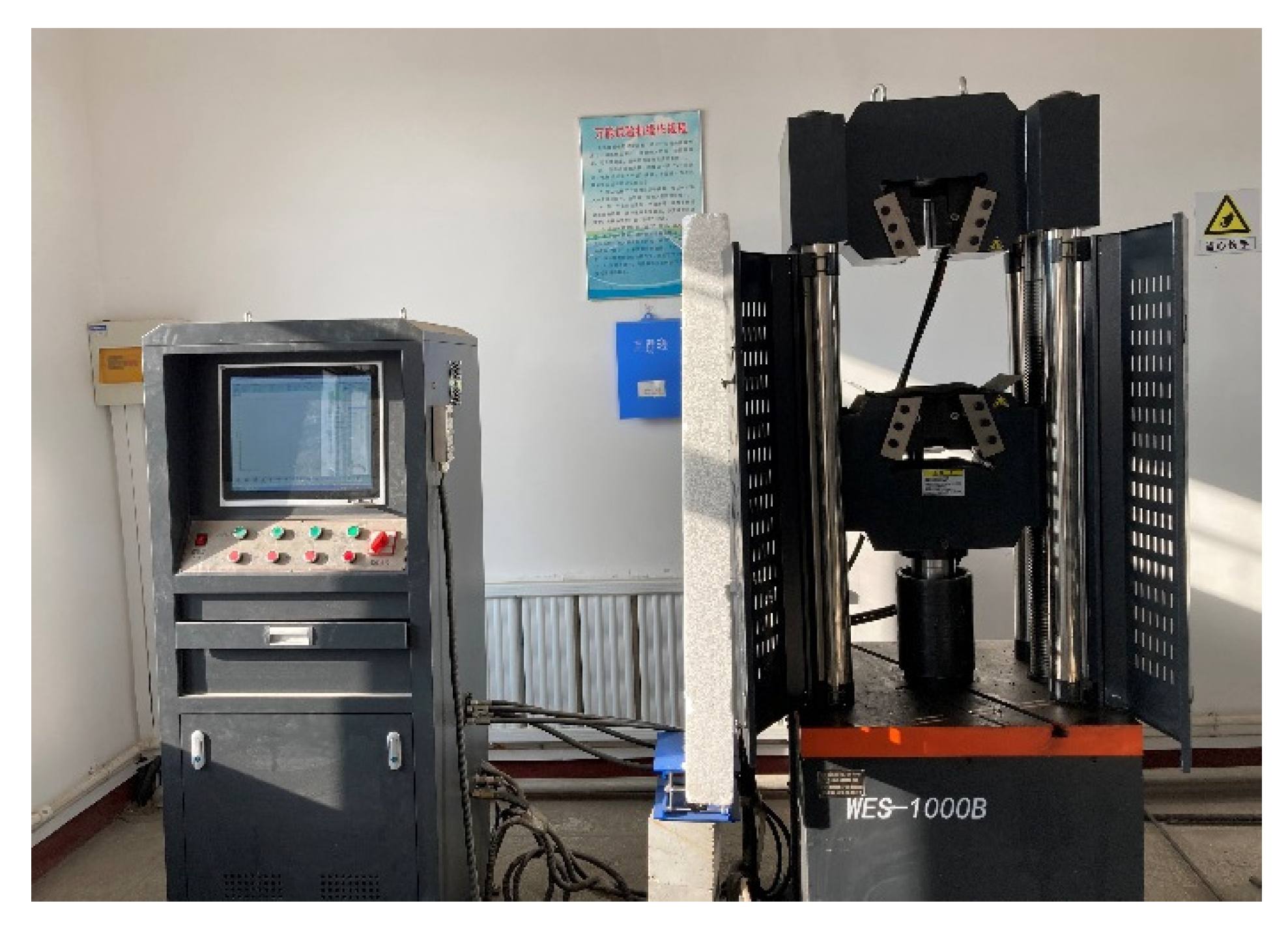
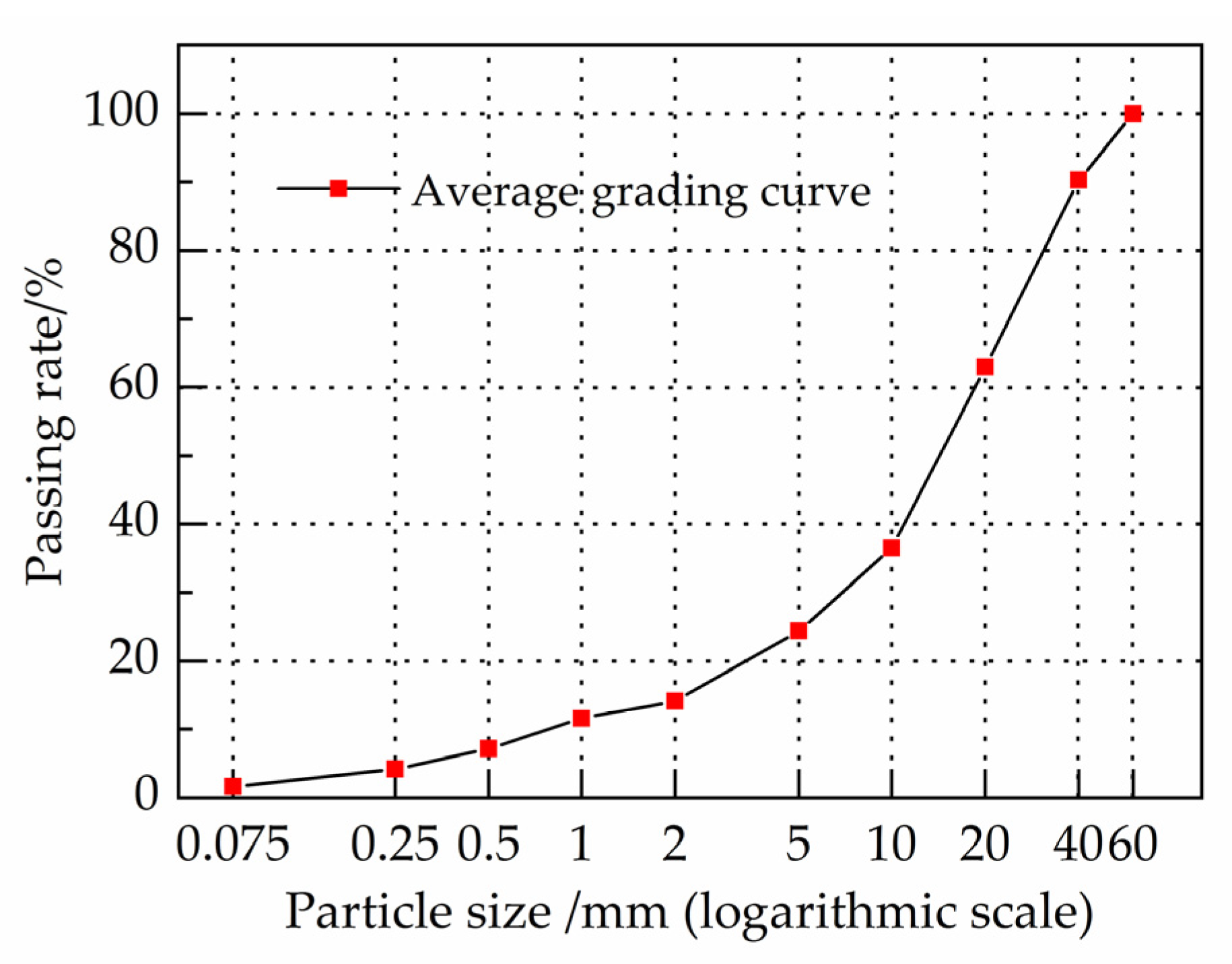

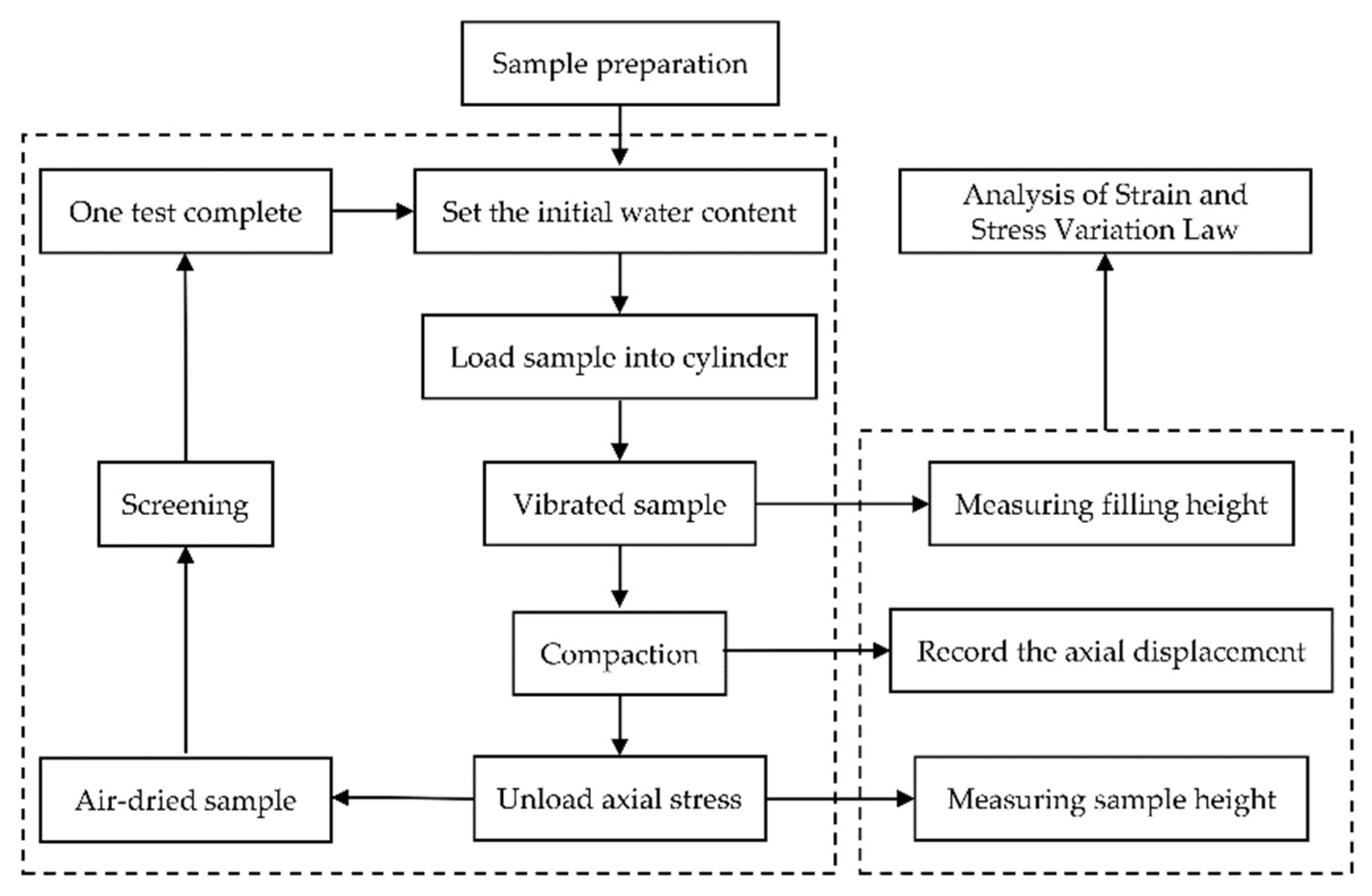


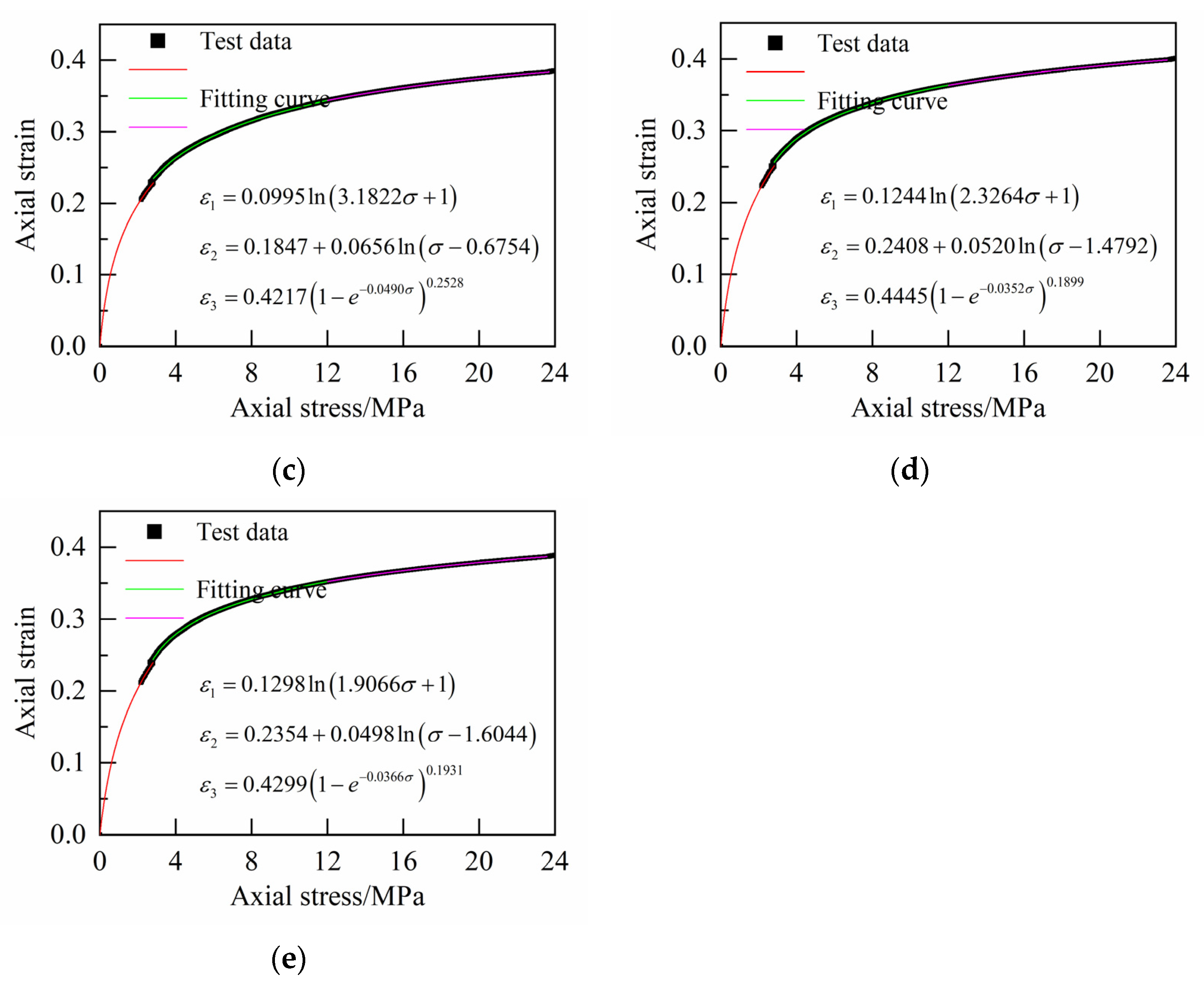
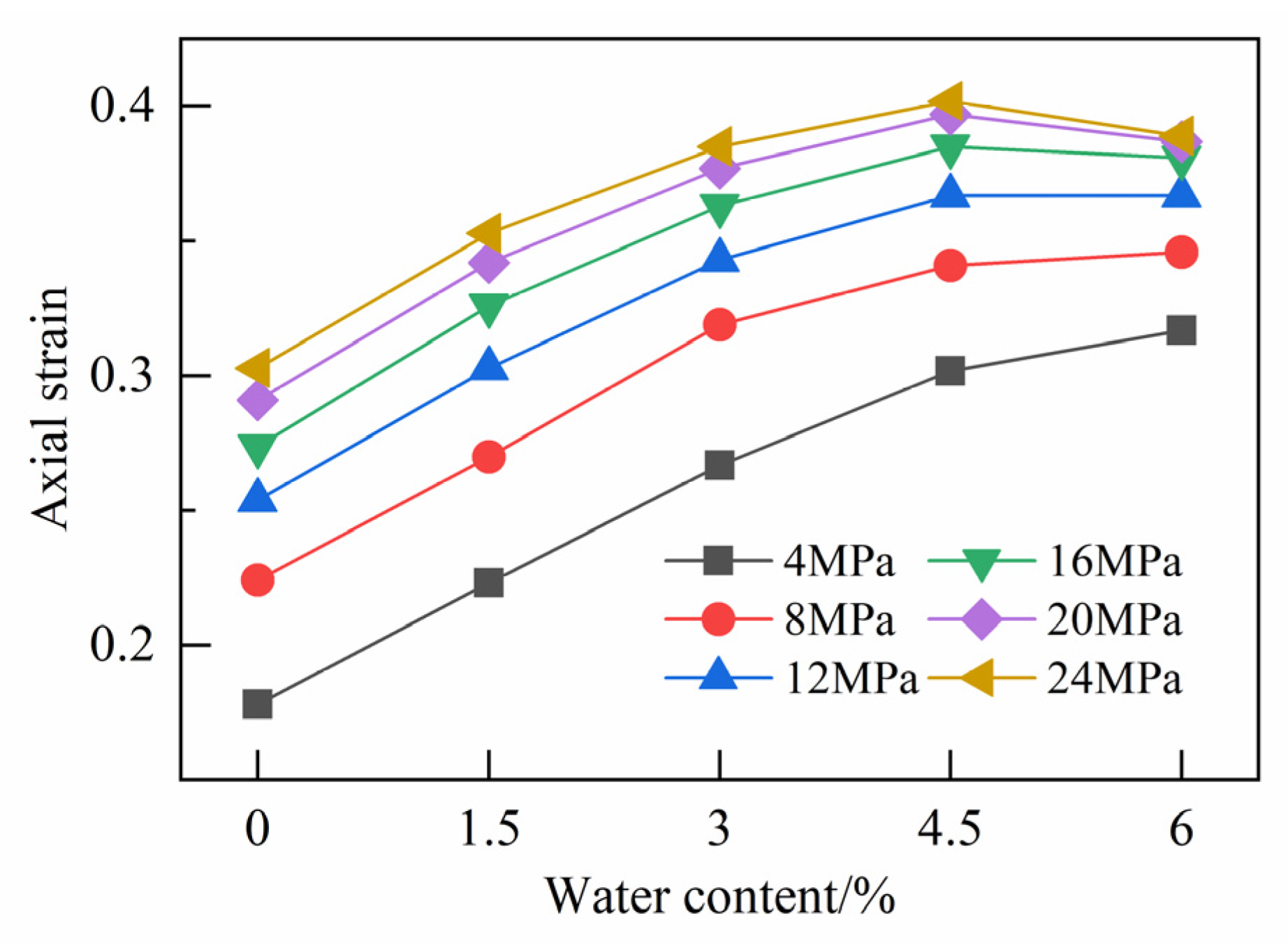
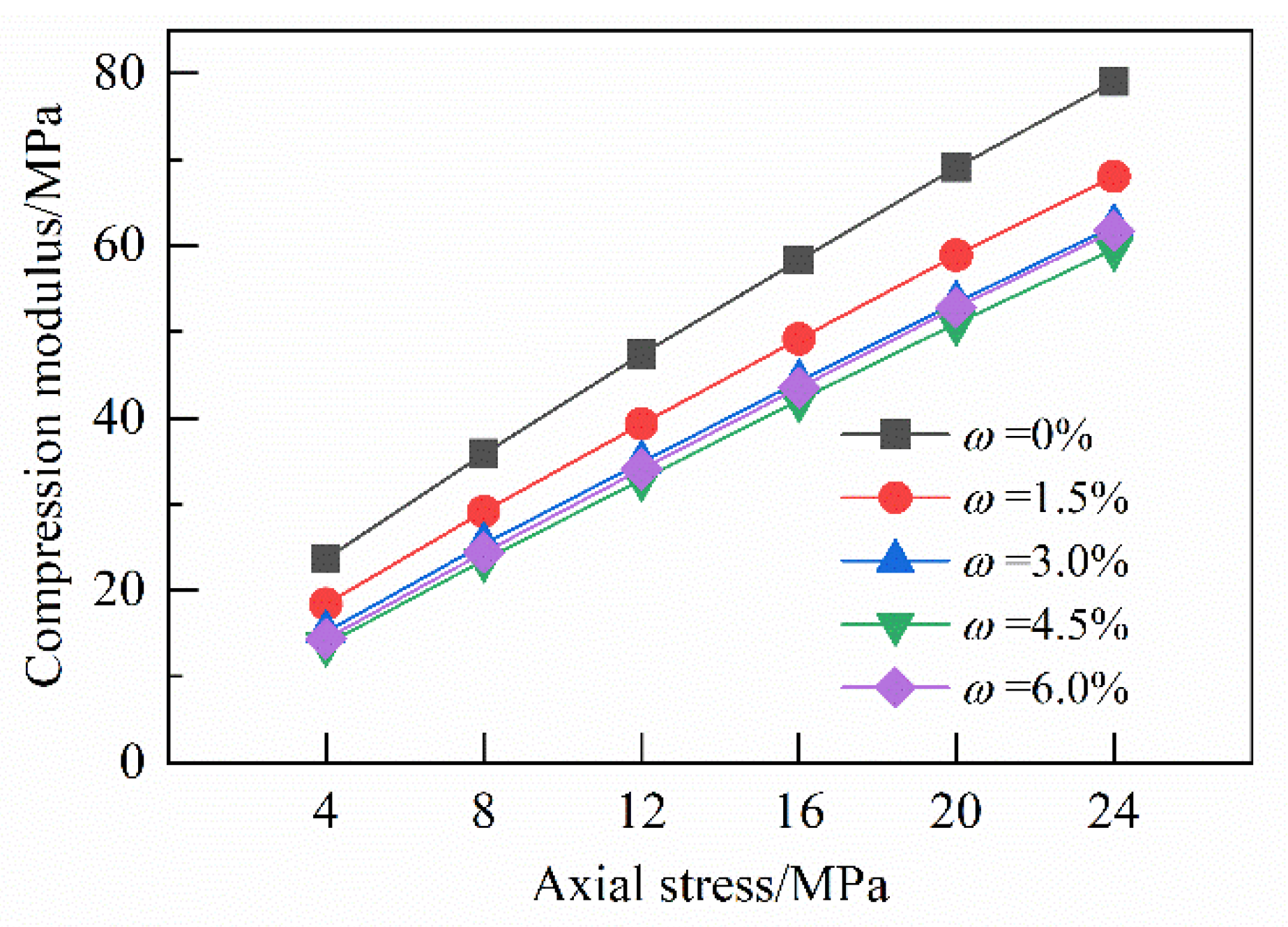


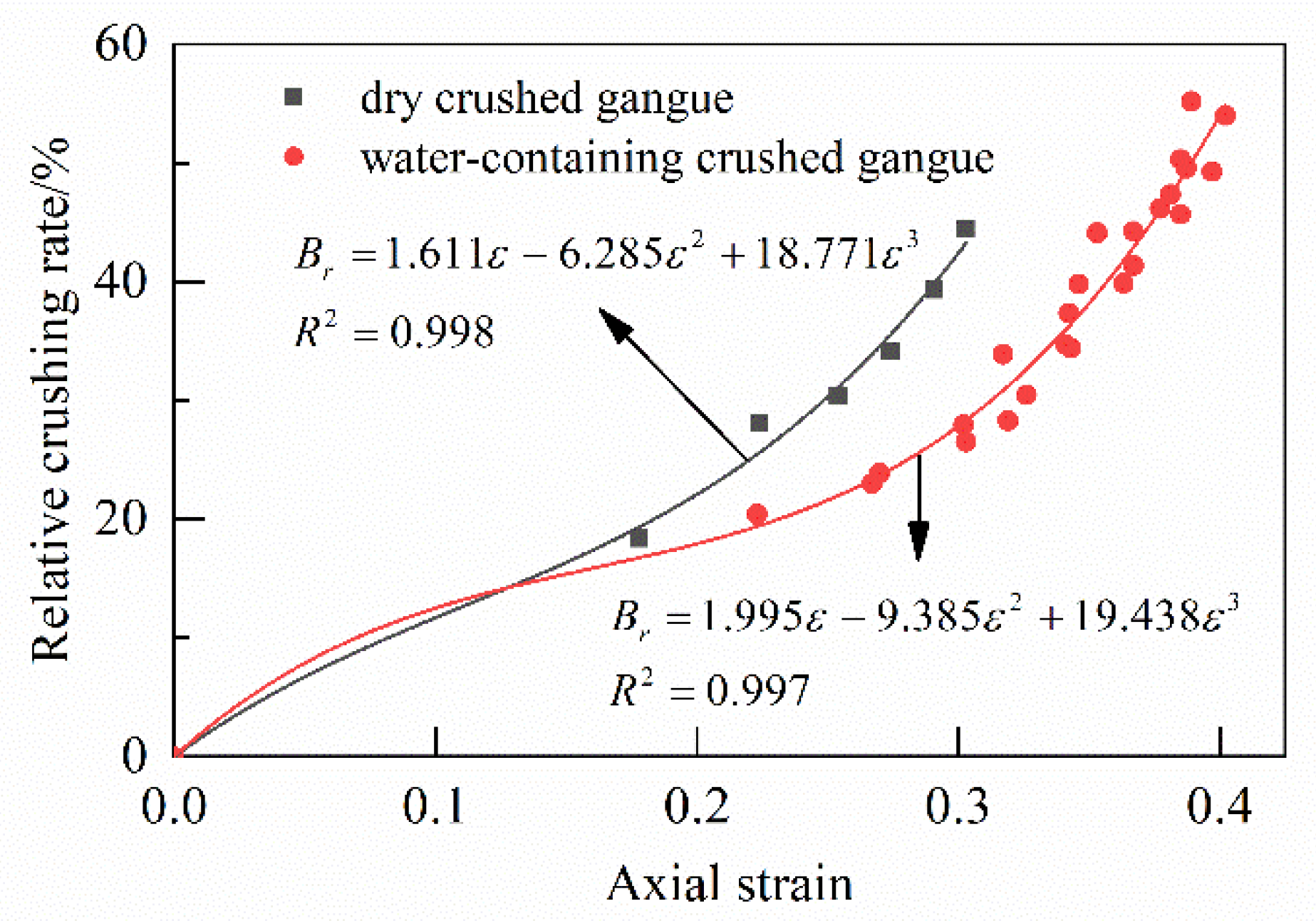
| Natural Bulk Density /kg·m−3 | Tapped Bulk Density /kg·m−3 | Apparent Density /kg·m−3 | Surface Dry Density /kg·m−3 | Gross Volume Density /kg·m−3 | Water Absorption/% |
|---|---|---|---|---|---|
| 1295 | 1551 | 2520 | 2369 | 2269 | 4.50 |
| Test No. | Water Content/% | Axial Stress/MPa |
|---|---|---|
| Group 1 | 0 | 4, 8, 12, 16, 20, 24 |
| Group 2 | 1.5 | 4, 8, 12, 16, 20, 24 |
| Group 3 | 3.0 | 4, 8, 12, 16, 20, 24 |
| Group 4 | 4.5 | 4, 8, 12, 16, 20, 24 |
| Group 5 | 6.0 | 4, 8, 12, 16, 20, 24 |
| Axial Stress/MPa | Optimal Water Content/% | Maximum Axial Strain |
|---|---|---|
| 16 MPa | 5.11 | 0.387 |
| 20 MPa | 4.91 | 0.398 |
| 24 MPa | 4.79 | 0.403 |
| Water Content/% | Fitting Equation | R2 |
|---|---|---|
| 0 | 0.9988 | |
| 1.5 | 0.9993 | |
| 3.0 | 0.9994 | |
| 4.5 | 0.9996 | |
| 6.0 | 0.9996 |
Disclaimer/Publisher’s Note: The statements, opinions and data contained in all publications are solely those of the individual author(s) and contributor(s) and not of MDPI and/or the editor(s). MDPI and/or the editor(s) disclaim responsibility for any injury to people or property resulting from any ideas, methods, instructions or products referred to in the content. |
© 2023 by the authors. Licensee MDPI, Basel, Switzerland. This article is an open access article distributed under the terms and conditions of the Creative Commons Attribution (CC BY) license (https://creativecommons.org/licenses/by/4.0/).
Share and Cite
Liang, P.; Yang, Y.; Liu, J.; Xin, C.; Sun, Y. Experimental Study on Confined Compaction Deformation of Crushed Gangue under Different Water Content Conditions. Appl. Sci. 2023, 13, 4538. https://doi.org/10.3390/app13074538
Liang P, Yang Y, Liu J, Xin C, Sun Y. Experimental Study on Confined Compaction Deformation of Crushed Gangue under Different Water Content Conditions. Applied Sciences. 2023; 13(7):4538. https://doi.org/10.3390/app13074538
Chicago/Turabian StyleLiang, Pengfei, Yu Yang, Jiashun Liu, Changhao Xin, and Yidan Sun. 2023. "Experimental Study on Confined Compaction Deformation of Crushed Gangue under Different Water Content Conditions" Applied Sciences 13, no. 7: 4538. https://doi.org/10.3390/app13074538





